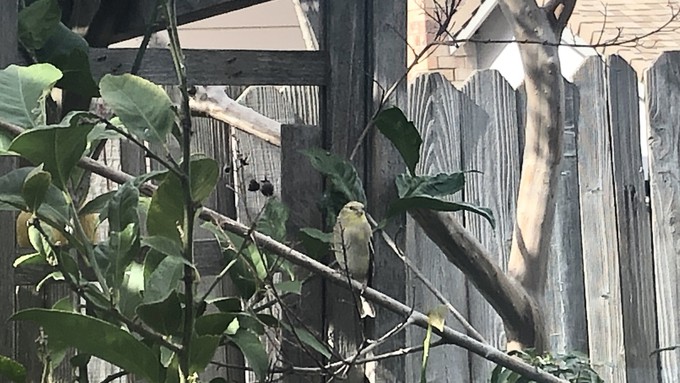
Great Backyard Bird Count can be done in parks or nature areas as well as at home

Whether it involves spotting lesser goldfinches in your backyard, as above, or myriad birds in a nearby wildlife site, anyone can participate this weekend in the Great Backyard Bird Count. Kathy Morrison
Got 15 minutes to spare for the birds? The Great Backyard Bird Count is back.
Starting Friday and through this holiday weekend, anyone can help contribute to a real-time snapshot of bird populations.
The National AudubonSociety naturally is involved in the event, and explains it like this:
“Participants are asked to count birds for as little as 15 minutes (or as long as they wish) on one or more days of the four-day event and report their sightings online at birdcount.org. Anyone can take part in the Great Backyard Bird Count, from beginning bird watchers to experts, and you can participate from your backyard, or anywhere in the world.”
How to participate? Here’s the guide from birdcount.org (also available at the link):
1) Count birds anywhere you like for at LEAST 15 minutes – or for as long as you wish. Keep track of the kinds of birds you see and how long you watched.
2) Make your best estimate of how many birds you saw of each species. For example, 5 Northern Cardinals, 3 American Crows. Huge flocks may be a challenge, but your best guess is still valuable.
3) Enter your list(s) online at www.birdcount.org. Put in a new checklist:
– for each new day
– for each different location
– for the same location, same day, if you counted at a different time of day.
The observation data are used by ornithologists to learn how birds are doing overall and how to protect them and the environment we all share.
Gardeners of course depend on birds to control insect pests as well as contribute to the diversity and beauty of our outdoor world.
If you’re not already familiar with the birds in your neighborhood, I recommend downloading the free Merlin app today, or at least before you start counting. (The account you create will be used to file your bird-count checklist, too.) Merlin was created by the Cornell Lab of Ornithology to help anyone identify, by photo or by sound, the birds around them. You can download a list of birds common to the western United States. I especially like to record on my phone the call or song of a bird I can’t see.
The Sacramento Audubon Society also maintains an online list of Sacramento-area birds, which is so helpful in learning all the feathered neighbors.
Birdcount.org also has excellent tips on identifying and counting birds.
You can be sure I'll be out in the wilds of my backyard Friday, with binoculars and phone at ready.
Comments
0 comments have been posted.Sacramento Digs Gardening to your inbox.
Sites We Like
Garden Checklist for week of July 21
Your garden needs you!
* Keep your vegetable garden watered, mulched and weeded. Water before 8 a.m. to reduce the chance of fungal infection and to conserve moisture.
* Feed vegetable plants bone meal, rock phosphate or other fertilizers high in phosphate to stimulate more blooms and fruiting. (But wait until daily high temperatures drop out of the 100s.)
* Don’t let tomatoes wilt or dry out completely. Give tomatoes a deep watering two to three times a week.
* Harvest vegetables promptly to encourage plants to produce more. Squash especially tends to grow rapidly in hot weather. Keep an eye on zucchini.
* Pinch back chrysanthemums for bushy plants and more flowers in September.
* Remove spent flowers from roses, daylilies and other bloomers as they finish flowering.
* Pinch off blooms from basil so the plant will grow more leaves.
* Cut back lavender after flowering to promote a second bloom.
* It's not too late to add a splash of color. Plant petunias, snapdragons, zinnias and marigolds.
* From seed, plant corn, pumpkins, radishes, winter squash and sunflowers.